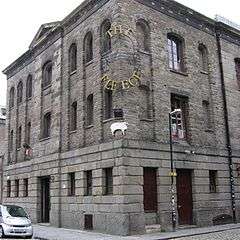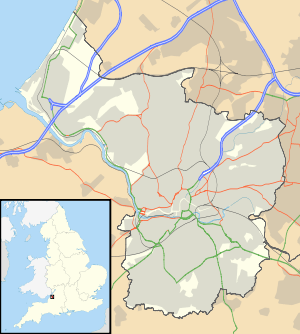Wool Hall, Bristol
| The Wool Hall | |
|---|---|
 | |
 Location within Bristol | |
| General information | |
| Architectural style | Neoclassical |
| Town or city | Bristol |
| Country | England |
| Coordinates | 51°27′08″N 2°35′22″W / 51.4522°N 2.5894°WCoordinates: 51°27′08″N 2°35′22″W / 51.4522°N 2.5894°W |
| Completed | 1830 |
| Cost | £4400[1] |
| Design and construction | |
| Architect | Richard Shackleton Pope |
The Wool Hall is a historic building in St Thomas Street, Redcliffe, Bristol.
History
Wool had been a popular trade in Bristol since the 11th century, but the smell generated by fullers softening wool in urine meant the trade was banished from the city centre and forced to relocate to Redcliffe.[2]
The building was constructed in 1830 to house the city's wool market,[1] as Bristol Bridge had become too congested by sheep farmers travelling across it.[3] It was designed by Richard Shackleton Pope and has been described as 'the first quasi-industrial building in Bristol to attempt a real architectural facade'.[4] It was designed in the classical style with a symmetrical front. Internally, the building included a Pennant-flagged ground floor and staircase.[5] The ground floor served as a weighing house, while upstairs was used for storage. The total cost was £4,400 (now £361,500). The premises was not a success as it was too far to travel from the farmer's markets at Temple Meads, and the wool trade moved to the Corn Exchange in 1834.[3]
The building survived the bombing of Bristol during World War II, unlike several 17th-century buildings adjacent to it which were hit and subsequently demolished.[6] In 1980, the building was modified to include new doors. It now houses offices and a pub, appropriately named The Fleece.[5][7] The pub has been a popular small live music venue in Bristol, hosting gigs by Oasis, Pulp, Emeli Sande, Radiohead and Amy Winehouse.[7]
The Wool Hall was awarded grade II listed building status by English Heritage in 1975.[4]
See also
References
- 1 2 "Wool Hall". Looking at Buildings. Archived from the original on 2007-09-27. Retrieved 2007-05-12.
- ↑ MacVeigh, James (2016). Secret Bristol. Amberley Publishing. p. 19. ISBN 978-144-565010-4.
- 1 2 "Some history". Wool Hall serviced offices. Retrieved 10 August 2016.
- 1 2 "No.12 The Wool Hall, including the Fleece and Firkin Public House". Images of England. Retrieved 2007-05-12.
- 1 2 "The Wool Hall, Including the Fleece and Firkin Public House, Bristol". British Listed Buildings. Retrieved 10 August 2016.
- ↑ "Discovering the history beneath our feet". Bristol 24/7. 26 May 2010. Retrieved 10 August 2016.
- 1 2 "The future of one of Bristol's most iconic music venues is under threat". Bristol Post. 12 March 2015. Retrieved 10 August 2016.